Strategic Decision Making in Health: IT Issues and Solutions
VerifiedAdded on 2022/11/01
|9
|3551
|224
Report
AI Summary
This report delves into the strategic decision-making processes within the healthcare sector, specifically focusing on the influence of information technology (IT). It highlights the benefits of IT in enhancing healthcare quality, efficiency, and patient care, while also addressing significant challenges such as data breaches, HIPAA compliance, and the need for robust security measures. The report examines IT's impact on various hospital departments, including structural, human resource, and political aspects. It discusses issues related to 24/7 operations, staff training, data management, and the integration of IT into healthcare policies. The analysis covers topics such as the importance of electronic medical records, the role of HR in managing IT-related changes, and the influence of government regulations. The report emphasizes the need for healthcare organizations to balance privacy and security with the advancement of IT infrastructure, ultimately aiming to provide insights into the complexities of implementing effective IT strategies in the healthcare environment.

Strategic decision making in health
Paraphrase This Document
Need a fresh take? Get an instant paraphrase of this document with our AI Paraphraser
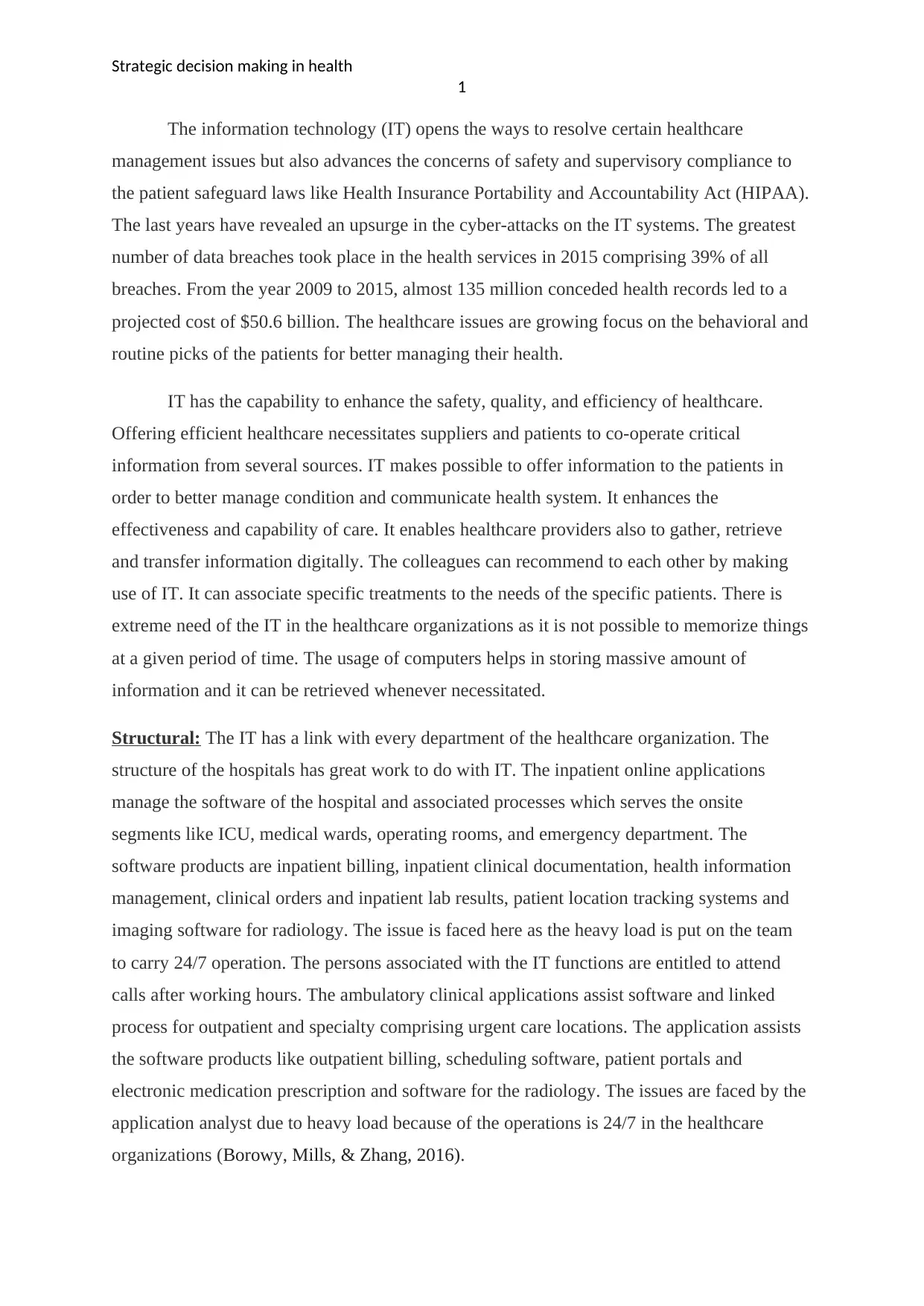
Strategic decision making in health
1
The information technology (IT) opens the ways to resolve certain healthcare
management issues but also advances the concerns of safety and supervisory compliance to
the patient safeguard laws like Health Insurance Portability and Accountability Act (HIPAA).
The last years have revealed an upsurge in the cyber-attacks on the IT systems. The greatest
number of data breaches took place in the health services in 2015 comprising 39% of all
breaches. From the year 2009 to 2015, almost 135 million conceded health records led to a
projected cost of $50.6 billion. The healthcare issues are growing focus on the behavioral and
routine picks of the patients for better managing their health.
IT has the capability to enhance the safety, quality, and efficiency of healthcare.
Offering efficient healthcare necessitates suppliers and patients to co-operate critical
information from several sources. IT makes possible to offer information to the patients in
order to better manage condition and communicate health system. It enhances the
effectiveness and capability of care. It enables healthcare providers also to gather, retrieve
and transfer information digitally. The colleagues can recommend to each other by making
use of IT. It can associate specific treatments to the needs of the specific patients. There is
extreme need of the IT in the healthcare organizations as it is not possible to memorize things
at a given period of time. The usage of computers helps in storing massive amount of
information and it can be retrieved whenever necessitated.
Structural: The IT has a link with every department of the healthcare organization. The
structure of the hospitals has great work to do with IT. The inpatient online applications
manage the software of the hospital and associated processes which serves the onsite
segments like ICU, medical wards, operating rooms, and emergency department. The
software products are inpatient billing, inpatient clinical documentation, health information
management, clinical orders and inpatient lab results, patient location tracking systems and
imaging software for radiology. The issue is faced here as the heavy load is put on the team
to carry 24/7 operation. The persons associated with the IT functions are entitled to attend
calls after working hours. The ambulatory clinical applications assist software and linked
process for outpatient and specialty comprising urgent care locations. The application assists
the software products like outpatient billing, scheduling software, patient portals and
electronic medication prescription and software for the radiology. The issues are faced by the
application analyst due to heavy load because of the operations is 24/7 in the healthcare
organizations (Borowy, Mills, & Zhang, 2016).
1
The information technology (IT) opens the ways to resolve certain healthcare
management issues but also advances the concerns of safety and supervisory compliance to
the patient safeguard laws like Health Insurance Portability and Accountability Act (HIPAA).
The last years have revealed an upsurge in the cyber-attacks on the IT systems. The greatest
number of data breaches took place in the health services in 2015 comprising 39% of all
breaches. From the year 2009 to 2015, almost 135 million conceded health records led to a
projected cost of $50.6 billion. The healthcare issues are growing focus on the behavioral and
routine picks of the patients for better managing their health.
IT has the capability to enhance the safety, quality, and efficiency of healthcare.
Offering efficient healthcare necessitates suppliers and patients to co-operate critical
information from several sources. IT makes possible to offer information to the patients in
order to better manage condition and communicate health system. It enhances the
effectiveness and capability of care. It enables healthcare providers also to gather, retrieve
and transfer information digitally. The colleagues can recommend to each other by making
use of IT. It can associate specific treatments to the needs of the specific patients. There is
extreme need of the IT in the healthcare organizations as it is not possible to memorize things
at a given period of time. The usage of computers helps in storing massive amount of
information and it can be retrieved whenever necessitated.
Structural: The IT has a link with every department of the healthcare organization. The
structure of the hospitals has great work to do with IT. The inpatient online applications
manage the software of the hospital and associated processes which serves the onsite
segments like ICU, medical wards, operating rooms, and emergency department. The
software products are inpatient billing, inpatient clinical documentation, health information
management, clinical orders and inpatient lab results, patient location tracking systems and
imaging software for radiology. The issue is faced here as the heavy load is put on the team
to carry 24/7 operation. The persons associated with the IT functions are entitled to attend
calls after working hours. The ambulatory clinical applications assist software and linked
process for outpatient and specialty comprising urgent care locations. The application assists
the software products like outpatient billing, scheduling software, patient portals and
electronic medication prescription and software for the radiology. The issues are faced by the
application analyst due to heavy load because of the operations is 24/7 in the healthcare
organizations (Borowy, Mills, & Zhang, 2016).
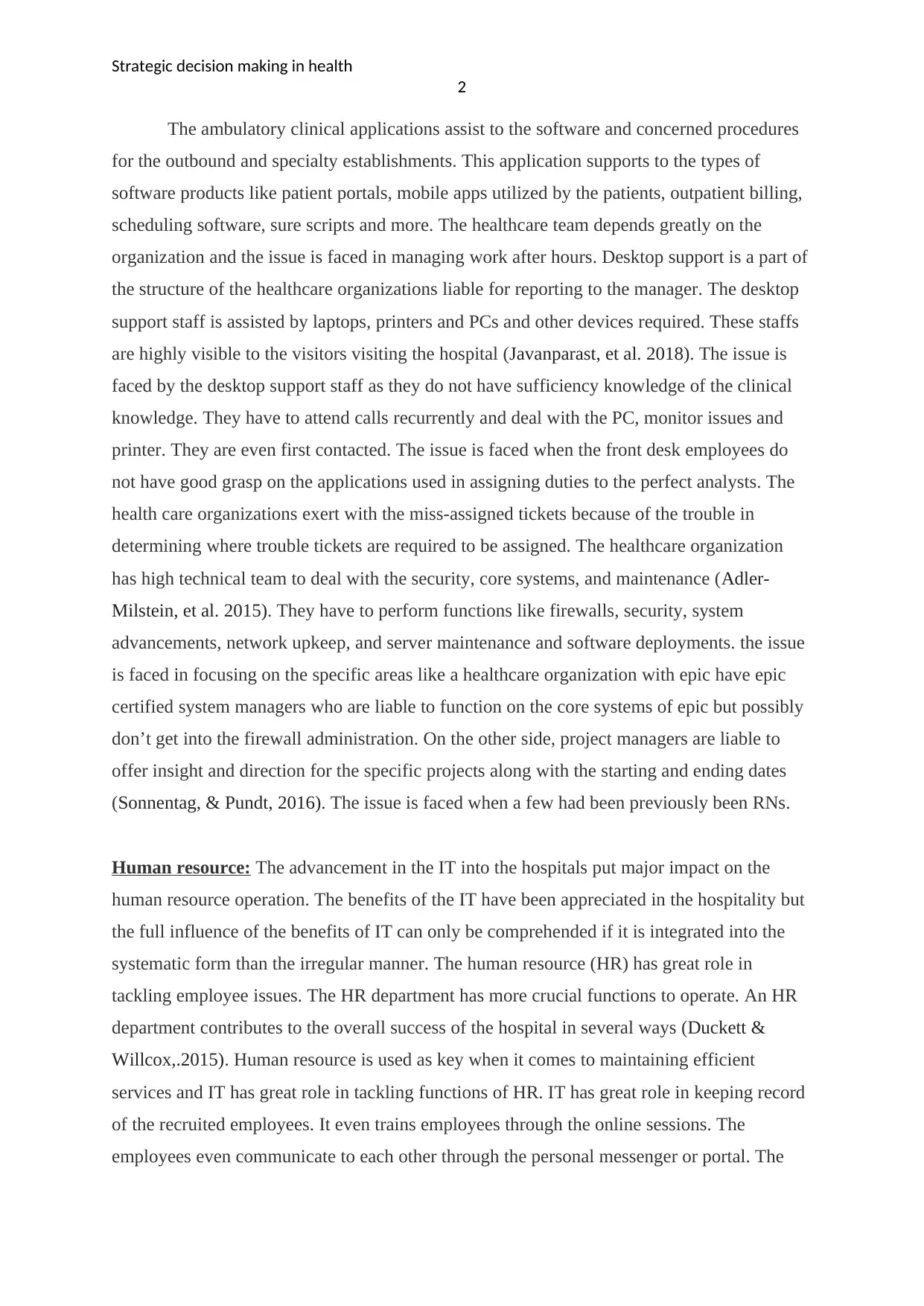
Strategic decision making in health
2
The ambulatory clinical applications assist to the software and concerned procedures
for the outbound and specialty establishments. This application supports to the types of
software products like patient portals, mobile apps utilized by the patients, outpatient billing,
scheduling software, sure scripts and more. The healthcare team depends greatly on the
organization and the issue is faced in managing work after hours. Desktop support is a part of
the structure of the healthcare organizations liable for reporting to the manager. The desktop
support staff is assisted by laptops, printers and PCs and other devices required. These staffs
are highly visible to the visitors visiting the hospital (Javanparast, et al. 2018). The issue is
faced by the desktop support staff as they do not have sufficiency knowledge of the clinical
knowledge. They have to attend calls recurrently and deal with the PC, monitor issues and
printer. They are even first contacted. The issue is faced when the front desk employees do
not have good grasp on the applications used in assigning duties to the perfect analysts. The
health care organizations exert with the miss-assigned tickets because of the trouble in
determining where trouble tickets are required to be assigned. The healthcare organization
has high technical team to deal with the security, core systems, and maintenance (Adler-
Milstein, et al. 2015). They have to perform functions like firewalls, security, system
advancements, network upkeep, and server maintenance and software deployments. the issue
is faced in focusing on the specific areas like a healthcare organization with epic have epic
certified system managers who are liable to function on the core systems of epic but possibly
don’t get into the firewall administration. On the other side, project managers are liable to
offer insight and direction for the specific projects along with the starting and ending dates
(Sonnentag, & Pundt, 2016). The issue is faced when a few had been previously been RNs.
Human resource: The advancement in the IT into the hospitals put major impact on the
human resource operation. The benefits of the IT have been appreciated in the hospitality but
the full influence of the benefits of IT can only be comprehended if it is integrated into the
systematic form than the irregular manner. The human resource (HR) has great role in
tackling employee issues. The HR department has more crucial functions to operate. An HR
department contributes to the overall success of the hospital in several ways (Duckett &
Willcox,.2015). Human resource is used as key when it comes to maintaining efficient
services and IT has great role in tackling functions of HR. IT has great role in keeping record
of the recruited employees. It even trains employees through the online sessions. The
employees even communicate to each other through the personal messenger or portal. The
2
The ambulatory clinical applications assist to the software and concerned procedures
for the outbound and specialty establishments. This application supports to the types of
software products like patient portals, mobile apps utilized by the patients, outpatient billing,
scheduling software, sure scripts and more. The healthcare team depends greatly on the
organization and the issue is faced in managing work after hours. Desktop support is a part of
the structure of the healthcare organizations liable for reporting to the manager. The desktop
support staff is assisted by laptops, printers and PCs and other devices required. These staffs
are highly visible to the visitors visiting the hospital (Javanparast, et al. 2018). The issue is
faced by the desktop support staff as they do not have sufficiency knowledge of the clinical
knowledge. They have to attend calls recurrently and deal with the PC, monitor issues and
printer. They are even first contacted. The issue is faced when the front desk employees do
not have good grasp on the applications used in assigning duties to the perfect analysts. The
health care organizations exert with the miss-assigned tickets because of the trouble in
determining where trouble tickets are required to be assigned. The healthcare organization
has high technical team to deal with the security, core systems, and maintenance (Adler-
Milstein, et al. 2015). They have to perform functions like firewalls, security, system
advancements, network upkeep, and server maintenance and software deployments. the issue
is faced in focusing on the specific areas like a healthcare organization with epic have epic
certified system managers who are liable to function on the core systems of epic but possibly
don’t get into the firewall administration. On the other side, project managers are liable to
offer insight and direction for the specific projects along with the starting and ending dates
(Sonnentag, & Pundt, 2016). The issue is faced when a few had been previously been RNs.
Human resource: The advancement in the IT into the hospitals put major impact on the
human resource operation. The benefits of the IT have been appreciated in the hospitality but
the full influence of the benefits of IT can only be comprehended if it is integrated into the
systematic form than the irregular manner. The human resource (HR) has great role in
tackling employee issues. The HR department has more crucial functions to operate. An HR
department contributes to the overall success of the hospital in several ways (Duckett &
Willcox,.2015). Human resource is used as key when it comes to maintaining efficient
services and IT has great role in tackling functions of HR. IT has great role in keeping record
of the recruited employees. It even trains employees through the online sessions. The
employees even communicate to each other through the personal messenger or portal. The
⊘ This is a preview!⊘
Do you want full access?
Subscribe today to unlock all pages.

Trusted by 1+ million students worldwide
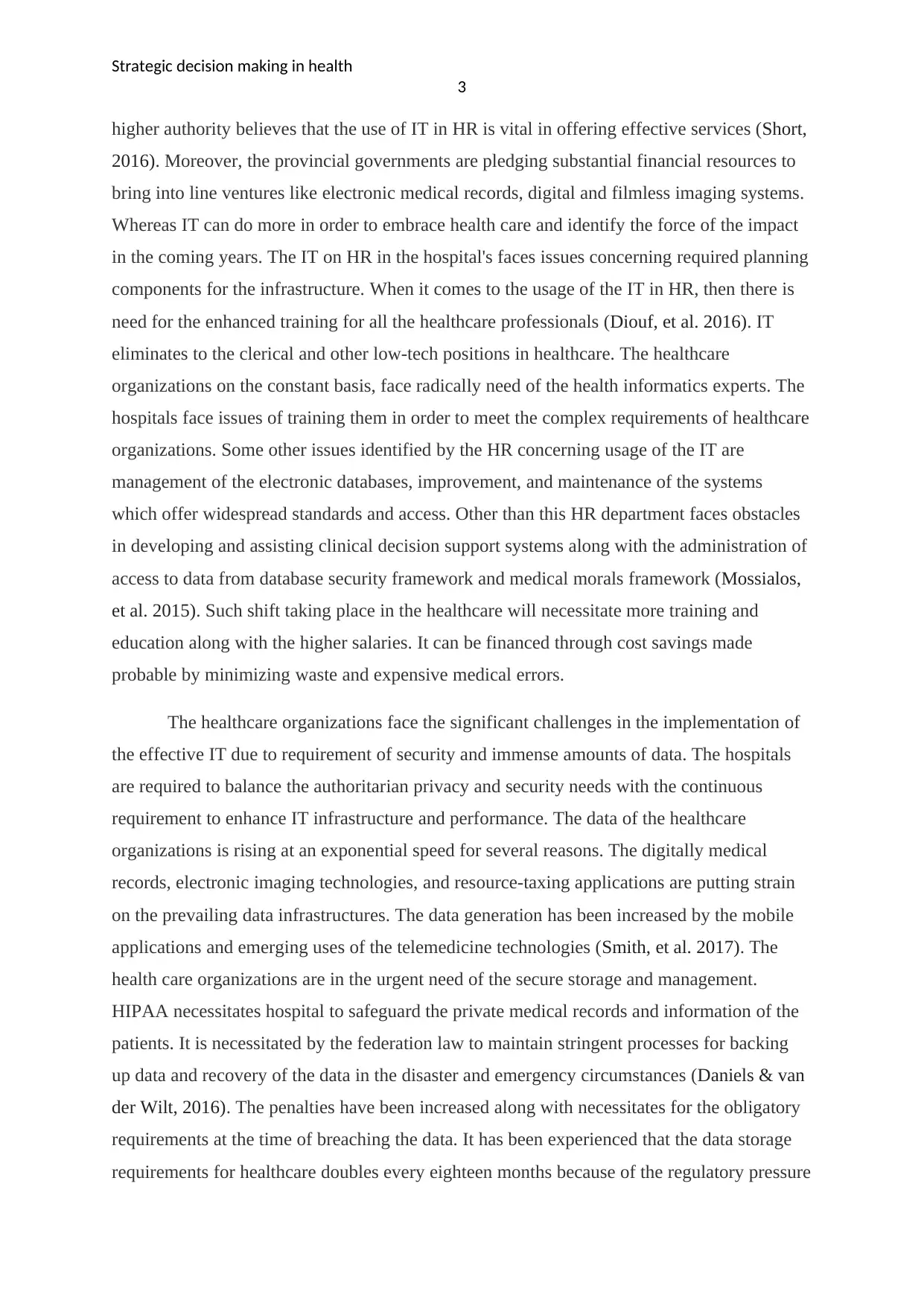
Strategic decision making in health
3
higher authority believes that the use of IT in HR is vital in offering effective services (Short,
2016). Moreover, the provincial governments are pledging substantial financial resources to
bring into line ventures like electronic medical records, digital and filmless imaging systems.
Whereas IT can do more in order to embrace health care and identify the force of the impact
in the coming years. The IT on HR in the hospital's faces issues concerning required planning
components for the infrastructure. When it comes to the usage of the IT in HR, then there is
need for the enhanced training for all the healthcare professionals (Diouf, et al. 2016). IT
eliminates to the clerical and other low-tech positions in healthcare. The healthcare
organizations on the constant basis, face radically need of the health informatics experts. The
hospitals face issues of training them in order to meet the complex requirements of healthcare
organizations. Some other issues identified by the HR concerning usage of the IT are
management of the electronic databases, improvement, and maintenance of the systems
which offer widespread standards and access. Other than this HR department faces obstacles
in developing and assisting clinical decision support systems along with the administration of
access to data from database security framework and medical morals framework (Mossialos,
et al. 2015). Such shift taking place in the healthcare will necessitate more training and
education along with the higher salaries. It can be financed through cost savings made
probable by minimizing waste and expensive medical errors.
The healthcare organizations face the significant challenges in the implementation of
the effective IT due to requirement of security and immense amounts of data. The hospitals
are required to balance the authoritarian privacy and security needs with the continuous
requirement to enhance IT infrastructure and performance. The data of the healthcare
organizations is rising at an exponential speed for several reasons. The digitally medical
records, electronic imaging technologies, and resource-taxing applications are putting strain
on the prevailing data infrastructures. The data generation has been increased by the mobile
applications and emerging uses of the telemedicine technologies (Smith, et al. 2017). The
health care organizations are in the urgent need of the secure storage and management.
HIPAA necessitates hospital to safeguard the private medical records and information of the
patients. It is necessitated by the federation law to maintain stringent processes for backing
up data and recovery of the data in the disaster and emergency circumstances (Daniels & van
der Wilt, 2016). The penalties have been increased along with necessitates for the obligatory
requirements at the time of breaching the data. It has been experienced that the data storage
requirements for healthcare doubles every eighteen months because of the regulatory pressure
3
higher authority believes that the use of IT in HR is vital in offering effective services (Short,
2016). Moreover, the provincial governments are pledging substantial financial resources to
bring into line ventures like electronic medical records, digital and filmless imaging systems.
Whereas IT can do more in order to embrace health care and identify the force of the impact
in the coming years. The IT on HR in the hospital's faces issues concerning required planning
components for the infrastructure. When it comes to the usage of the IT in HR, then there is
need for the enhanced training for all the healthcare professionals (Diouf, et al. 2016). IT
eliminates to the clerical and other low-tech positions in healthcare. The healthcare
organizations on the constant basis, face radically need of the health informatics experts. The
hospitals face issues of training them in order to meet the complex requirements of healthcare
organizations. Some other issues identified by the HR concerning usage of the IT are
management of the electronic databases, improvement, and maintenance of the systems
which offer widespread standards and access. Other than this HR department faces obstacles
in developing and assisting clinical decision support systems along with the administration of
access to data from database security framework and medical morals framework (Mossialos,
et al. 2015). Such shift taking place in the healthcare will necessitate more training and
education along with the higher salaries. It can be financed through cost savings made
probable by minimizing waste and expensive medical errors.
The healthcare organizations face the significant challenges in the implementation of
the effective IT due to requirement of security and immense amounts of data. The hospitals
are required to balance the authoritarian privacy and security needs with the continuous
requirement to enhance IT infrastructure and performance. The data of the healthcare
organizations is rising at an exponential speed for several reasons. The digitally medical
records, electronic imaging technologies, and resource-taxing applications are putting strain
on the prevailing data infrastructures. The data generation has been increased by the mobile
applications and emerging uses of the telemedicine technologies (Smith, et al. 2017). The
health care organizations are in the urgent need of the secure storage and management.
HIPAA necessitates hospital to safeguard the private medical records and information of the
patients. It is necessitated by the federation law to maintain stringent processes for backing
up data and recovery of the data in the disaster and emergency circumstances (Daniels & van
der Wilt, 2016). The penalties have been increased along with necessitates for the obligatory
requirements at the time of breaching the data. It has been experienced that the data storage
requirements for healthcare doubles every eighteen months because of the regulatory pressure
Paraphrase This Document
Need a fresh take? Get an instant paraphrase of this document with our AI Paraphraser
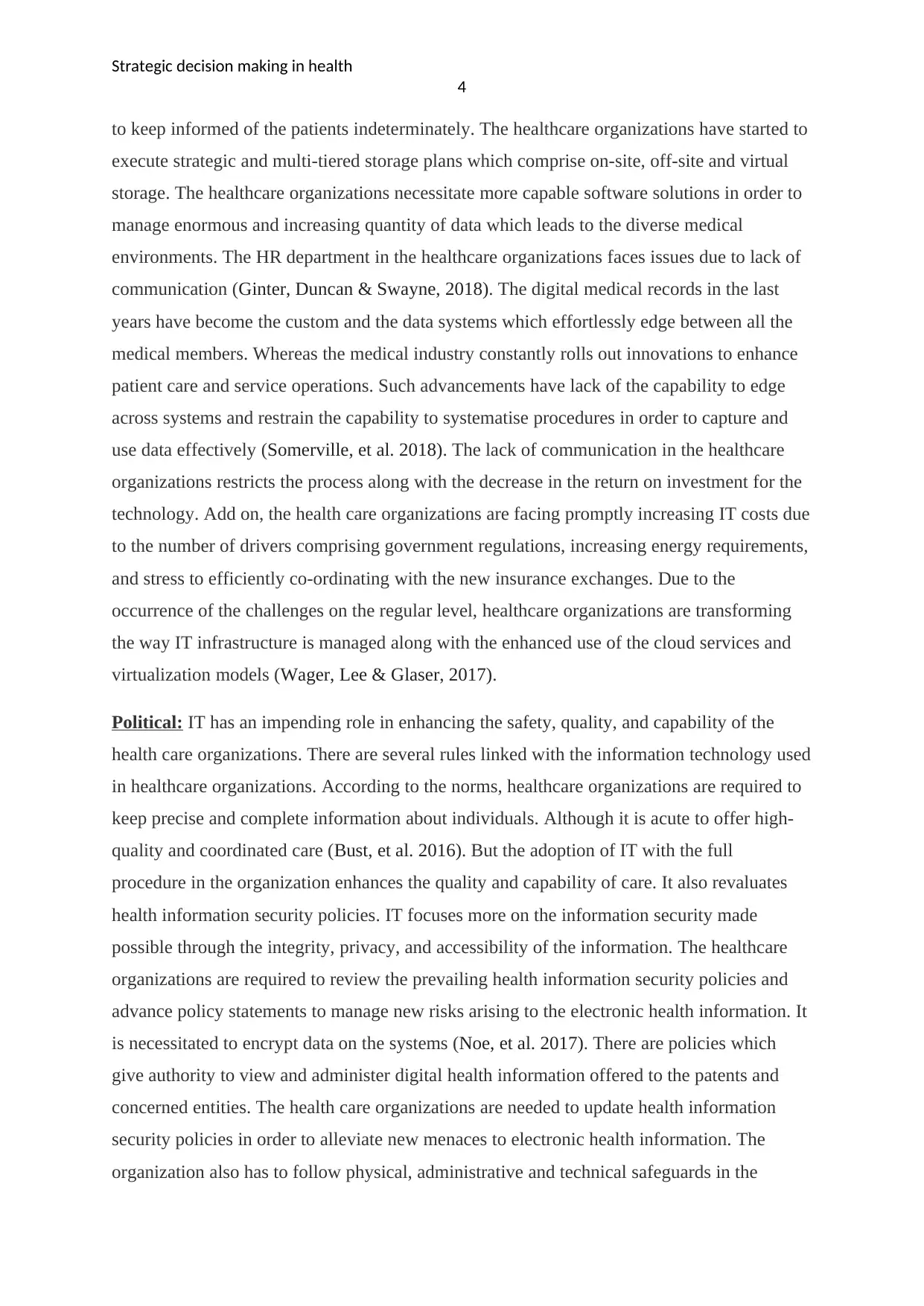
Strategic decision making in health
4
to keep informed of the patients indeterminately. The healthcare organizations have started to
execute strategic and multi-tiered storage plans which comprise on-site, off-site and virtual
storage. The healthcare organizations necessitate more capable software solutions in order to
manage enormous and increasing quantity of data which leads to the diverse medical
environments. The HR department in the healthcare organizations faces issues due to lack of
communication (Ginter, Duncan & Swayne, 2018). The digital medical records in the last
years have become the custom and the data systems which effortlessly edge between all the
medical members. Whereas the medical industry constantly rolls out innovations to enhance
patient care and service operations. Such advancements have lack of the capability to edge
across systems and restrain the capability to systematise procedures in order to capture and
use data effectively (Somerville, et al. 2018). The lack of communication in the healthcare
organizations restricts the process along with the decrease in the return on investment for the
technology. Add on, the health care organizations are facing promptly increasing IT costs due
to the number of drivers comprising government regulations, increasing energy requirements,
and stress to efficiently co-ordinating with the new insurance exchanges. Due to the
occurrence of the challenges on the regular level, healthcare organizations are transforming
the way IT infrastructure is managed along with the enhanced use of the cloud services and
virtualization models (Wager, Lee & Glaser, 2017).
Political: IT has an impending role in enhancing the safety, quality, and capability of the
health care organizations. There are several rules linked with the information technology used
in healthcare organizations. According to the norms, healthcare organizations are required to
keep precise and complete information about individuals. Although it is acute to offer high-
quality and coordinated care (Bust, et al. 2016). But the adoption of IT with the full
procedure in the organization enhances the quality and capability of care. It also revaluates
health information security policies. IT focuses more on the information security made
possible through the integrity, privacy, and accessibility of the information. The healthcare
organizations are required to review the prevailing health information security policies and
advance policy statements to manage new risks arising to the electronic health information. It
is necessitated to encrypt data on the systems (Noe, et al. 2017). There are policies which
give authority to view and administer digital health information offered to the patents and
concerned entities. The health care organizations are needed to update health information
security policies in order to alleviate new menaces to electronic health information. The
organization also has to follow physical, administrative and technical safeguards in the
4
to keep informed of the patients indeterminately. The healthcare organizations have started to
execute strategic and multi-tiered storage plans which comprise on-site, off-site and virtual
storage. The healthcare organizations necessitate more capable software solutions in order to
manage enormous and increasing quantity of data which leads to the diverse medical
environments. The HR department in the healthcare organizations faces issues due to lack of
communication (Ginter, Duncan & Swayne, 2018). The digital medical records in the last
years have become the custom and the data systems which effortlessly edge between all the
medical members. Whereas the medical industry constantly rolls out innovations to enhance
patient care and service operations. Such advancements have lack of the capability to edge
across systems and restrain the capability to systematise procedures in order to capture and
use data effectively (Somerville, et al. 2018). The lack of communication in the healthcare
organizations restricts the process along with the decrease in the return on investment for the
technology. Add on, the health care organizations are facing promptly increasing IT costs due
to the number of drivers comprising government regulations, increasing energy requirements,
and stress to efficiently co-ordinating with the new insurance exchanges. Due to the
occurrence of the challenges on the regular level, healthcare organizations are transforming
the way IT infrastructure is managed along with the enhanced use of the cloud services and
virtualization models (Wager, Lee & Glaser, 2017).
Political: IT has an impending role in enhancing the safety, quality, and capability of the
health care organizations. There are several rules linked with the information technology used
in healthcare organizations. According to the norms, healthcare organizations are required to
keep precise and complete information about individuals. Although it is acute to offer high-
quality and coordinated care (Bust, et al. 2016). But the adoption of IT with the full
procedure in the organization enhances the quality and capability of care. It also revaluates
health information security policies. IT focuses more on the information security made
possible through the integrity, privacy, and accessibility of the information. The healthcare
organizations are required to review the prevailing health information security policies and
advance policy statements to manage new risks arising to the electronic health information. It
is necessitated to encrypt data on the systems (Noe, et al. 2017). There are policies which
give authority to view and administer digital health information offered to the patents and
concerned entities. The health care organizations are needed to update health information
security policies in order to alleviate new menaces to electronic health information. The
organization also has to follow physical, administrative and technical safeguards in the
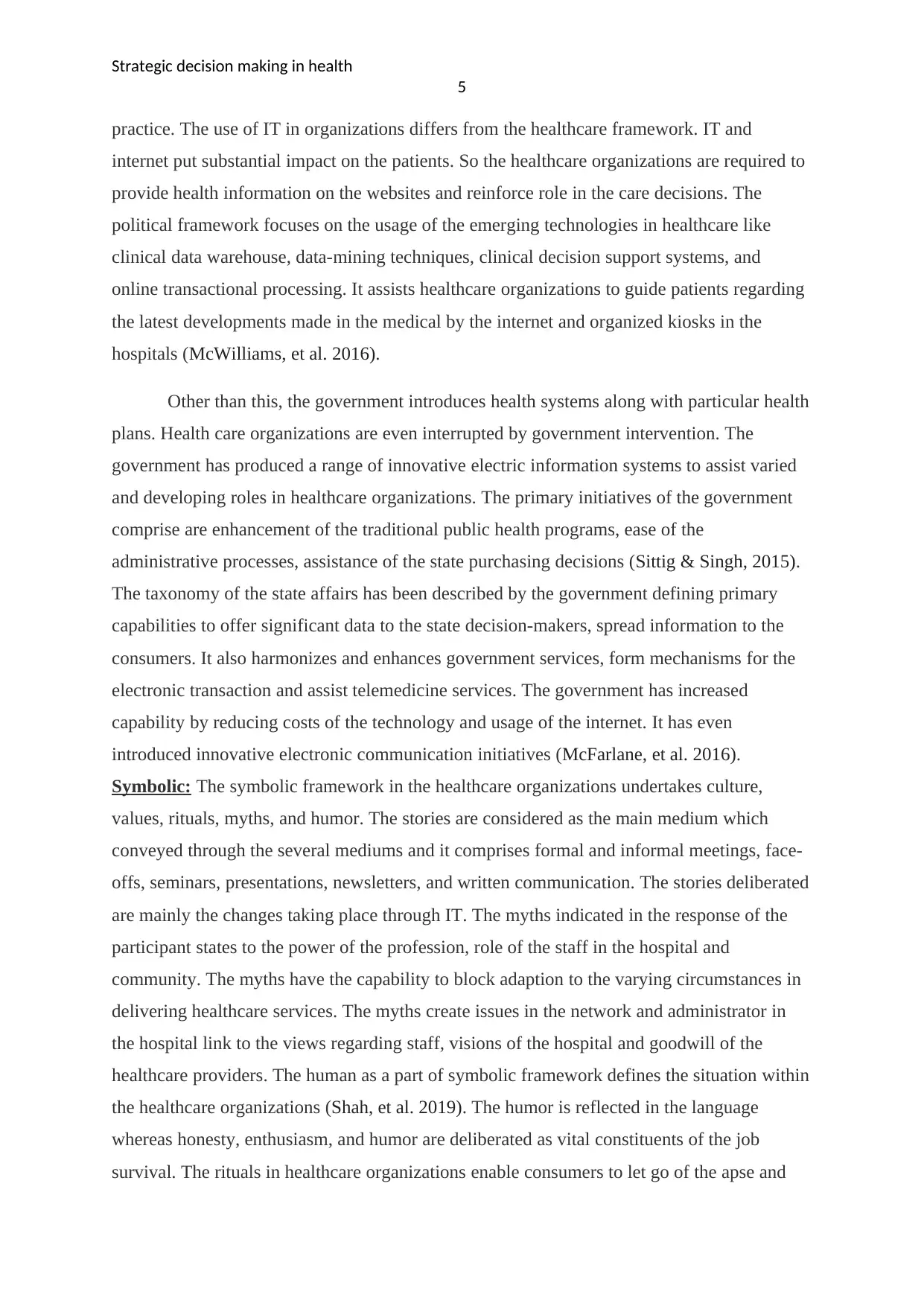
Strategic decision making in health
5
practice. The use of IT in organizations differs from the healthcare framework. IT and
internet put substantial impact on the patients. So the healthcare organizations are required to
provide health information on the websites and reinforce role in the care decisions. The
political framework focuses on the usage of the emerging technologies in healthcare like
clinical data warehouse, data-mining techniques, clinical decision support systems, and
online transactional processing. It assists healthcare organizations to guide patients regarding
the latest developments made in the medical by the internet and organized kiosks in the
hospitals (McWilliams, et al. 2016).
Other than this, the government introduces health systems along with particular health
plans. Health care organizations are even interrupted by government intervention. The
government has produced a range of innovative electric information systems to assist varied
and developing roles in healthcare organizations. The primary initiatives of the government
comprise are enhancement of the traditional public health programs, ease of the
administrative processes, assistance of the state purchasing decisions (Sittig & Singh, 2015).
The taxonomy of the state affairs has been described by the government defining primary
capabilities to offer significant data to the state decision-makers, spread information to the
consumers. It also harmonizes and enhances government services, form mechanisms for the
electronic transaction and assist telemedicine services. The government has increased
capability by reducing costs of the technology and usage of the internet. It has even
introduced innovative electronic communication initiatives (McFarlane, et al. 2016).
Symbolic: The symbolic framework in the healthcare organizations undertakes culture,
values, rituals, myths, and humor. The stories are considered as the main medium which
conveyed through the several mediums and it comprises formal and informal meetings, face-
offs, seminars, presentations, newsletters, and written communication. The stories deliberated
are mainly the changes taking place through IT. The myths indicated in the response of the
participant states to the power of the profession, role of the staff in the hospital and
community. The myths have the capability to block adaption to the varying circumstances in
delivering healthcare services. The myths create issues in the network and administrator in
the hospital link to the views regarding staff, visions of the hospital and goodwill of the
healthcare providers. The human as a part of symbolic framework defines the situation within
the healthcare organizations (Shah, et al. 2019). The humor is reflected in the language
whereas honesty, enthusiasm, and humor are deliberated as vital constituents of the job
survival. The rituals in healthcare organizations enable consumers to let go of the apse and
5
practice. The use of IT in organizations differs from the healthcare framework. IT and
internet put substantial impact on the patients. So the healthcare organizations are required to
provide health information on the websites and reinforce role in the care decisions. The
political framework focuses on the usage of the emerging technologies in healthcare like
clinical data warehouse, data-mining techniques, clinical decision support systems, and
online transactional processing. It assists healthcare organizations to guide patients regarding
the latest developments made in the medical by the internet and organized kiosks in the
hospitals (McWilliams, et al. 2016).
Other than this, the government introduces health systems along with particular health
plans. Health care organizations are even interrupted by government intervention. The
government has produced a range of innovative electric information systems to assist varied
and developing roles in healthcare organizations. The primary initiatives of the government
comprise are enhancement of the traditional public health programs, ease of the
administrative processes, assistance of the state purchasing decisions (Sittig & Singh, 2015).
The taxonomy of the state affairs has been described by the government defining primary
capabilities to offer significant data to the state decision-makers, spread information to the
consumers. It also harmonizes and enhances government services, form mechanisms for the
electronic transaction and assist telemedicine services. The government has increased
capability by reducing costs of the technology and usage of the internet. It has even
introduced innovative electronic communication initiatives (McFarlane, et al. 2016).
Symbolic: The symbolic framework in the healthcare organizations undertakes culture,
values, rituals, myths, and humor. The stories are considered as the main medium which
conveyed through the several mediums and it comprises formal and informal meetings, face-
offs, seminars, presentations, newsletters, and written communication. The stories deliberated
are mainly the changes taking place through IT. The myths indicated in the response of the
participant states to the power of the profession, role of the staff in the hospital and
community. The myths have the capability to block adaption to the varying circumstances in
delivering healthcare services. The myths create issues in the network and administrator in
the hospital link to the views regarding staff, visions of the hospital and goodwill of the
healthcare providers. The human as a part of symbolic framework defines the situation within
the healthcare organizations (Shah, et al. 2019). The humor is reflected in the language
whereas honesty, enthusiasm, and humor are deliberated as vital constituents of the job
survival. The rituals in healthcare organizations enable consumers to let go of the apse and
⊘ This is a preview!⊘
Do you want full access?
Subscribe today to unlock all pages.

Trusted by 1+ million students worldwide
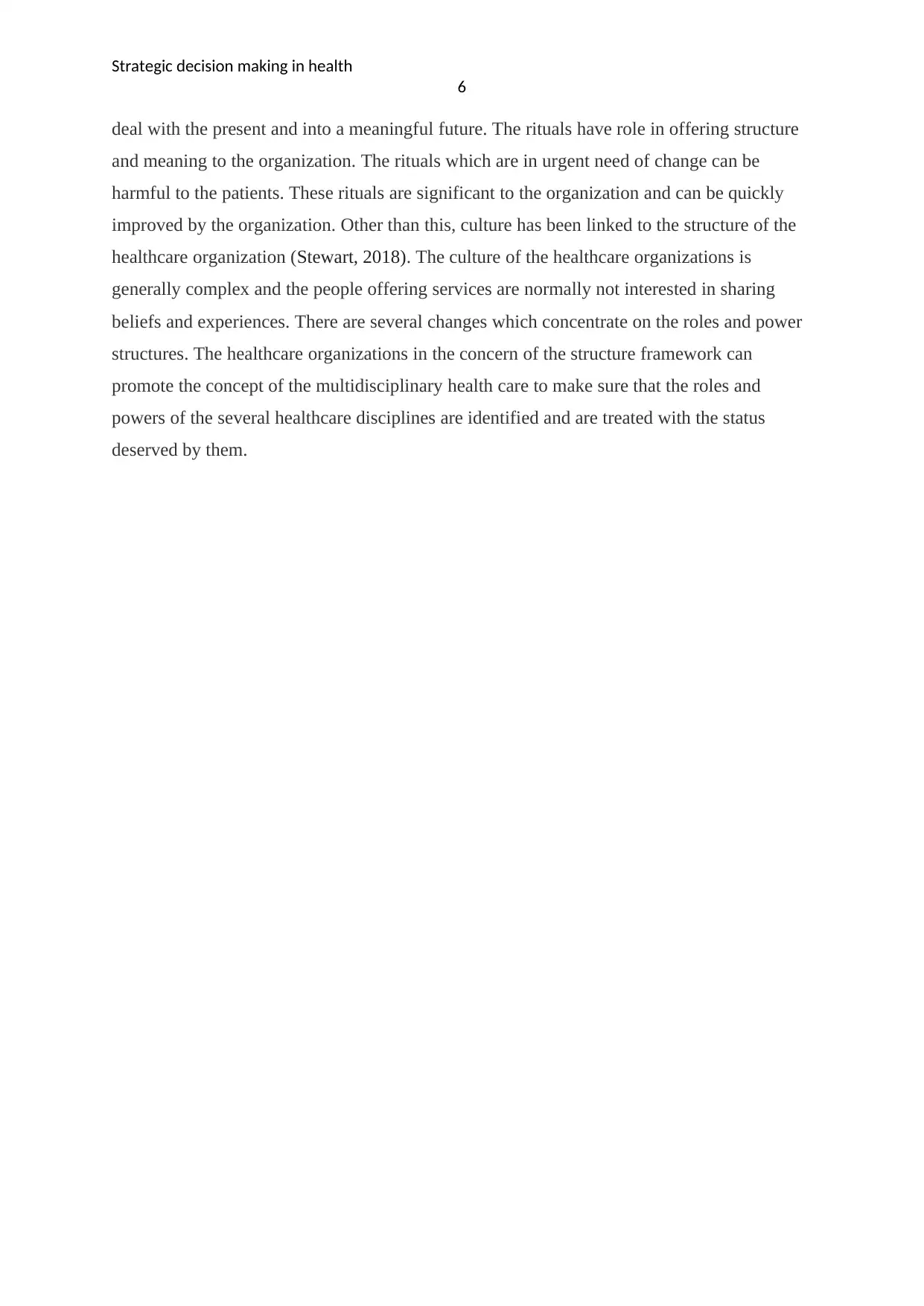
Strategic decision making in health
6
deal with the present and into a meaningful future. The rituals have role in offering structure
and meaning to the organization. The rituals which are in urgent need of change can be
harmful to the patients. These rituals are significant to the organization and can be quickly
improved by the organization. Other than this, culture has been linked to the structure of the
healthcare organization (Stewart, 2018). The culture of the healthcare organizations is
generally complex and the people offering services are normally not interested in sharing
beliefs and experiences. There are several changes which concentrate on the roles and power
structures. The healthcare organizations in the concern of the structure framework can
promote the concept of the multidisciplinary health care to make sure that the roles and
powers of the several healthcare disciplines are identified and are treated with the status
deserved by them.
6
deal with the present and into a meaningful future. The rituals have role in offering structure
and meaning to the organization. The rituals which are in urgent need of change can be
harmful to the patients. These rituals are significant to the organization and can be quickly
improved by the organization. Other than this, culture has been linked to the structure of the
healthcare organization (Stewart, 2018). The culture of the healthcare organizations is
generally complex and the people offering services are normally not interested in sharing
beliefs and experiences. There are several changes which concentrate on the roles and power
structures. The healthcare organizations in the concern of the structure framework can
promote the concept of the multidisciplinary health care to make sure that the roles and
powers of the several healthcare disciplines are identified and are treated with the status
deserved by them.
Paraphrase This Document
Need a fresh take? Get an instant paraphrase of this document with our AI Paraphraser
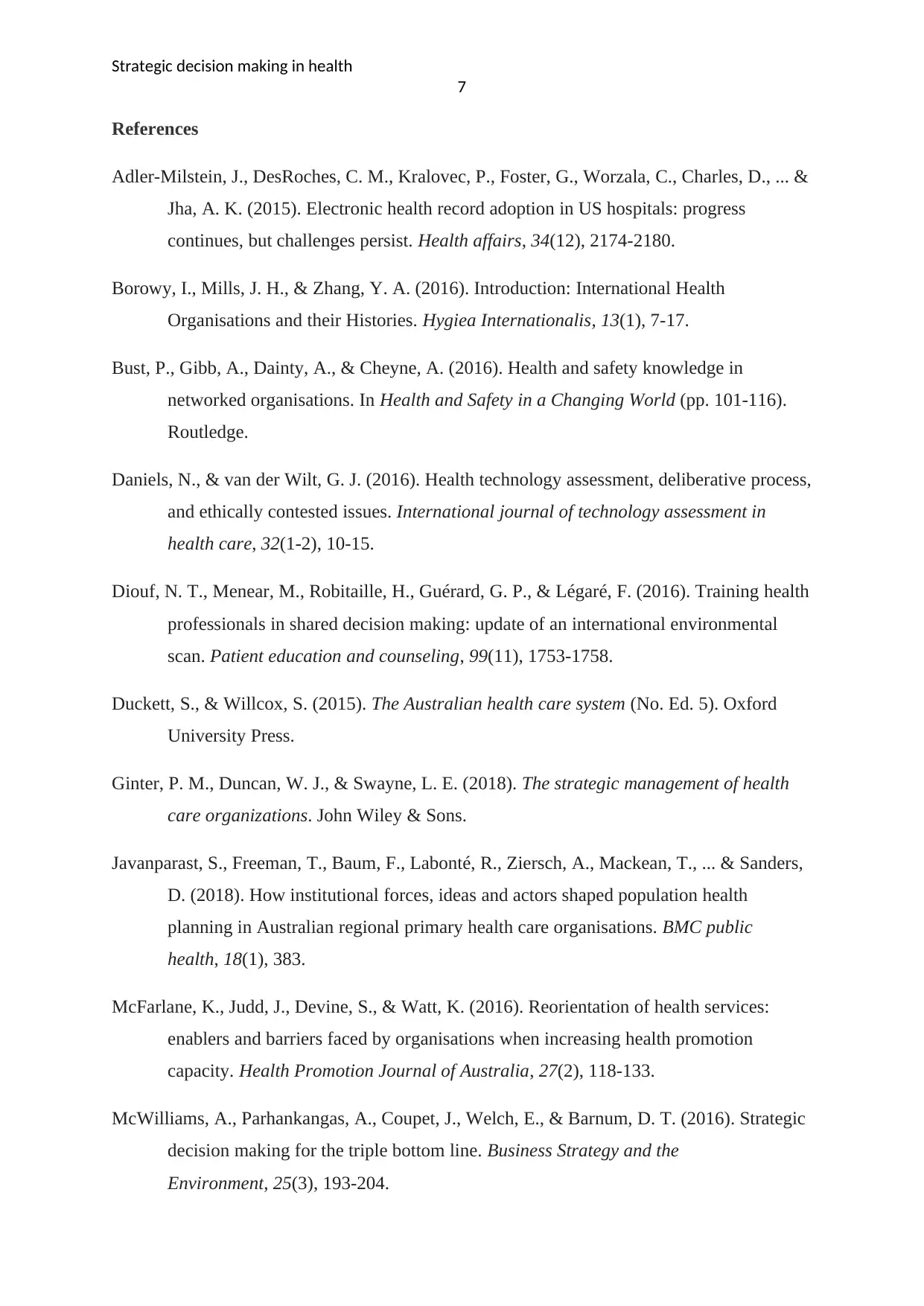
Strategic decision making in health
7
References
Adler-Milstein, J., DesRoches, C. M., Kralovec, P., Foster, G., Worzala, C., Charles, D., ... &
Jha, A. K. (2015). Electronic health record adoption in US hospitals: progress
continues, but challenges persist. Health affairs, 34(12), 2174-2180.
Borowy, I., Mills, J. H., & Zhang, Y. A. (2016). Introduction: International Health
Organisations and their Histories. Hygiea Internationalis, 13(1), 7-17.
Bust, P., Gibb, A., Dainty, A., & Cheyne, A. (2016). Health and safety knowledge in
networked organisations. In Health and Safety in a Changing World (pp. 101-116).
Routledge.
Daniels, N., & van der Wilt, G. J. (2016). Health technology assessment, deliberative process,
and ethically contested issues. International journal of technology assessment in
health care, 32(1-2), 10-15.
Diouf, N. T., Menear, M., Robitaille, H., Guérard, G. P., & Légaré, F. (2016). Training health
professionals in shared decision making: update of an international environmental
scan. Patient education and counseling, 99(11), 1753-1758.
Duckett, S., & Willcox, S. (2015). The Australian health care system (No. Ed. 5). Oxford
University Press.
Ginter, P. M., Duncan, W. J., & Swayne, L. E. (2018). The strategic management of health
care organizations. John Wiley & Sons.
Javanparast, S., Freeman, T., Baum, F., Labonté, R., Ziersch, A., Mackean, T., ... & Sanders,
D. (2018). How institutional forces, ideas and actors shaped population health
planning in Australian regional primary health care organisations. BMC public
health, 18(1), 383.
McFarlane, K., Judd, J., Devine, S., & Watt, K. (2016). Reorientation of health services:
enablers and barriers faced by organisations when increasing health promotion
capacity. Health Promotion Journal of Australia, 27(2), 118-133.
McWilliams, A., Parhankangas, A., Coupet, J., Welch, E., & Barnum, D. T. (2016). Strategic
decision making for the triple bottom line. Business Strategy and the
Environment, 25(3), 193-204.
7
References
Adler-Milstein, J., DesRoches, C. M., Kralovec, P., Foster, G., Worzala, C., Charles, D., ... &
Jha, A. K. (2015). Electronic health record adoption in US hospitals: progress
continues, but challenges persist. Health affairs, 34(12), 2174-2180.
Borowy, I., Mills, J. H., & Zhang, Y. A. (2016). Introduction: International Health
Organisations and their Histories. Hygiea Internationalis, 13(1), 7-17.
Bust, P., Gibb, A., Dainty, A., & Cheyne, A. (2016). Health and safety knowledge in
networked organisations. In Health and Safety in a Changing World (pp. 101-116).
Routledge.
Daniels, N., & van der Wilt, G. J. (2016). Health technology assessment, deliberative process,
and ethically contested issues. International journal of technology assessment in
health care, 32(1-2), 10-15.
Diouf, N. T., Menear, M., Robitaille, H., Guérard, G. P., & Légaré, F. (2016). Training health
professionals in shared decision making: update of an international environmental
scan. Patient education and counseling, 99(11), 1753-1758.
Duckett, S., & Willcox, S. (2015). The Australian health care system (No. Ed. 5). Oxford
University Press.
Ginter, P. M., Duncan, W. J., & Swayne, L. E. (2018). The strategic management of health
care organizations. John Wiley & Sons.
Javanparast, S., Freeman, T., Baum, F., Labonté, R., Ziersch, A., Mackean, T., ... & Sanders,
D. (2018). How institutional forces, ideas and actors shaped population health
planning in Australian regional primary health care organisations. BMC public
health, 18(1), 383.
McFarlane, K., Judd, J., Devine, S., & Watt, K. (2016). Reorientation of health services:
enablers and barriers faced by organisations when increasing health promotion
capacity. Health Promotion Journal of Australia, 27(2), 118-133.
McWilliams, A., Parhankangas, A., Coupet, J., Welch, E., & Barnum, D. T. (2016). Strategic
decision making for the triple bottom line. Business Strategy and the
Environment, 25(3), 193-204.
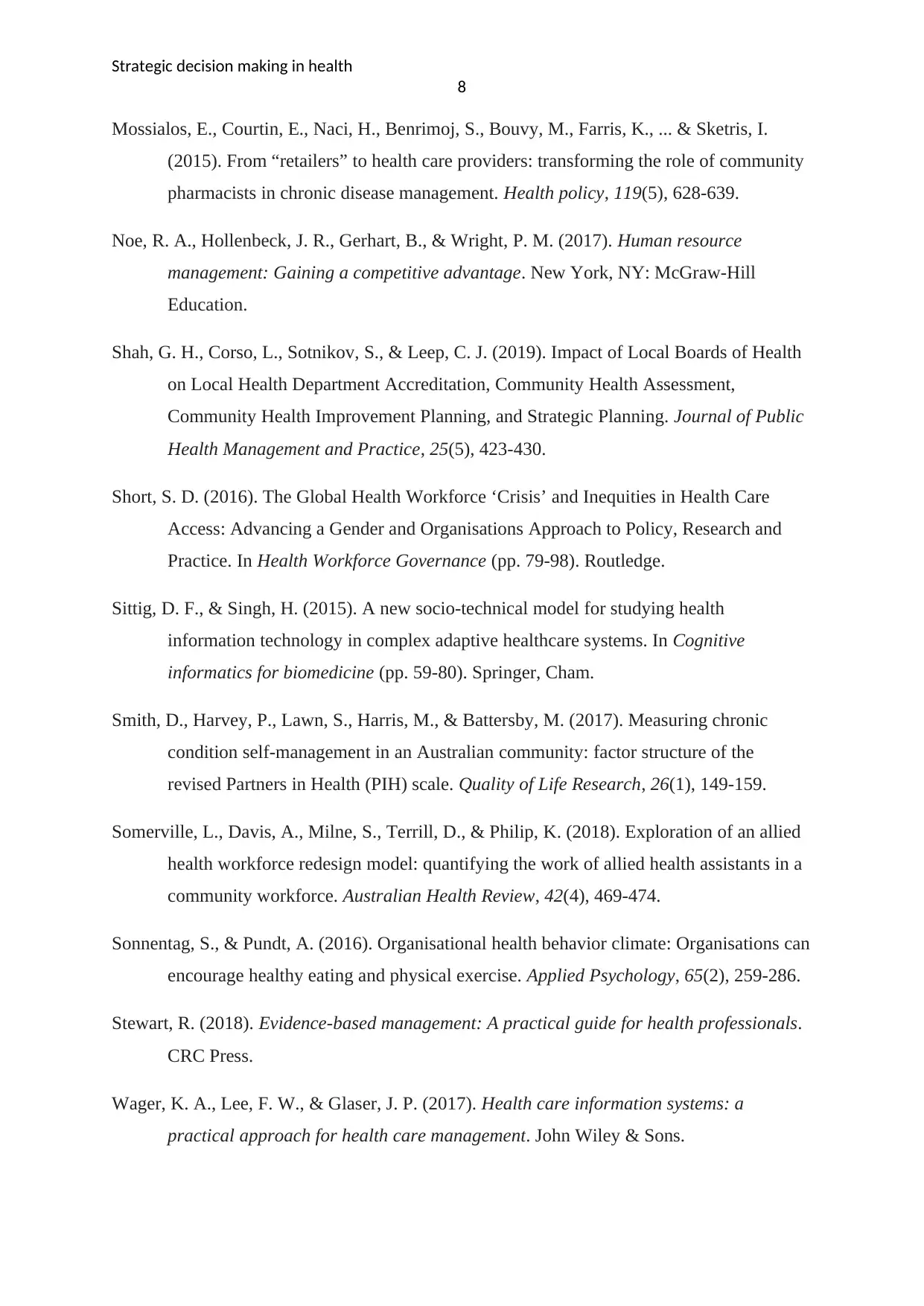
Strategic decision making in health
8
Mossialos, E., Courtin, E., Naci, H., Benrimoj, S., Bouvy, M., Farris, K., ... & Sketris, I.
(2015). From “retailers” to health care providers: transforming the role of community
pharmacists in chronic disease management. Health policy, 119(5), 628-639.
Noe, R. A., Hollenbeck, J. R., Gerhart, B., & Wright, P. M. (2017). Human resource
management: Gaining a competitive advantage. New York, NY: McGraw-Hill
Education.
Shah, G. H., Corso, L., Sotnikov, S., & Leep, C. J. (2019). Impact of Local Boards of Health
on Local Health Department Accreditation, Community Health Assessment,
Community Health Improvement Planning, and Strategic Planning. Journal of Public
Health Management and Practice, 25(5), 423-430.
Short, S. D. (2016). The Global Health Workforce ‘Crisis’ and Inequities in Health Care
Access: Advancing a Gender and Organisations Approach to Policy, Research and
Practice. In Health Workforce Governance (pp. 79-98). Routledge.
Sittig, D. F., & Singh, H. (2015). A new socio-technical model for studying health
information technology in complex adaptive healthcare systems. In Cognitive
informatics for biomedicine (pp. 59-80). Springer, Cham.
Smith, D., Harvey, P., Lawn, S., Harris, M., & Battersby, M. (2017). Measuring chronic
condition self-management in an Australian community: factor structure of the
revised Partners in Health (PIH) scale. Quality of Life Research, 26(1), 149-159.
Somerville, L., Davis, A., Milne, S., Terrill, D., & Philip, K. (2018). Exploration of an allied
health workforce redesign model: quantifying the work of allied health assistants in a
community workforce. Australian Health Review, 42(4), 469-474.
Sonnentag, S., & Pundt, A. (2016). Organisational health behavior climate: Organisations can
encourage healthy eating and physical exercise. Applied Psychology, 65(2), 259-286.
Stewart, R. (2018). Evidence-based management: A practical guide for health professionals.
CRC Press.
Wager, K. A., Lee, F. W., & Glaser, J. P. (2017). Health care information systems: a
practical approach for health care management. John Wiley & Sons.
8
Mossialos, E., Courtin, E., Naci, H., Benrimoj, S., Bouvy, M., Farris, K., ... & Sketris, I.
(2015). From “retailers” to health care providers: transforming the role of community
pharmacists in chronic disease management. Health policy, 119(5), 628-639.
Noe, R. A., Hollenbeck, J. R., Gerhart, B., & Wright, P. M. (2017). Human resource
management: Gaining a competitive advantage. New York, NY: McGraw-Hill
Education.
Shah, G. H., Corso, L., Sotnikov, S., & Leep, C. J. (2019). Impact of Local Boards of Health
on Local Health Department Accreditation, Community Health Assessment,
Community Health Improvement Planning, and Strategic Planning. Journal of Public
Health Management and Practice, 25(5), 423-430.
Short, S. D. (2016). The Global Health Workforce ‘Crisis’ and Inequities in Health Care
Access: Advancing a Gender and Organisations Approach to Policy, Research and
Practice. In Health Workforce Governance (pp. 79-98). Routledge.
Sittig, D. F., & Singh, H. (2015). A new socio-technical model for studying health
information technology in complex adaptive healthcare systems. In Cognitive
informatics for biomedicine (pp. 59-80). Springer, Cham.
Smith, D., Harvey, P., Lawn, S., Harris, M., & Battersby, M. (2017). Measuring chronic
condition self-management in an Australian community: factor structure of the
revised Partners in Health (PIH) scale. Quality of Life Research, 26(1), 149-159.
Somerville, L., Davis, A., Milne, S., Terrill, D., & Philip, K. (2018). Exploration of an allied
health workforce redesign model: quantifying the work of allied health assistants in a
community workforce. Australian Health Review, 42(4), 469-474.
Sonnentag, S., & Pundt, A. (2016). Organisational health behavior climate: Organisations can
encourage healthy eating and physical exercise. Applied Psychology, 65(2), 259-286.
Stewart, R. (2018). Evidence-based management: A practical guide for health professionals.
CRC Press.
Wager, K. A., Lee, F. W., & Glaser, J. P. (2017). Health care information systems: a
practical approach for health care management. John Wiley & Sons.
⊘ This is a preview!⊘
Do you want full access?
Subscribe today to unlock all pages.

Trusted by 1+ million students worldwide
1 out of 9
Related Documents
Your All-in-One AI-Powered Toolkit for Academic Success.
+13062052269
info@desklib.com
Available 24*7 on WhatsApp / Email
![[object Object]](/_next/static/media/star-bottom.7253800d.svg)
Unlock your academic potential
Copyright © 2020–2025 A2Z Services. All Rights Reserved. Developed and managed by ZUCOL.




